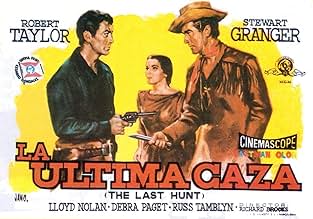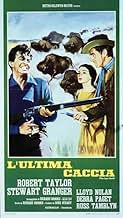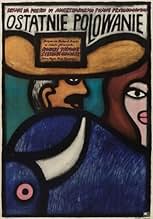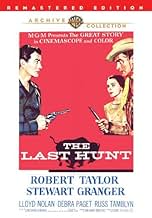IMDb RATING
6.8/10
2K
YOUR RATING
In 1883 South Dakota, two buffalo hunters start a personal feud over a captured squaw and a stand-off with a Dakota raiding party over some stolen horses.In 1883 South Dakota, two buffalo hunters start a personal feud over a captured squaw and a stand-off with a Dakota raiding party over some stolen horses.In 1883 South Dakota, two buffalo hunters start a personal feud over a captured squaw and a stand-off with a Dakota raiding party over some stolen horses.
Joe De Santis
- Ed Black
- (as Joe DeSantis)
Roy Barcroft
- Maj. Smith
- (uncredited)
Jimmie Booth
- Barfly
- (uncredited)
Steve Darrell
- Wells Fargo Man
- (uncredited)
Rosemary Johnston
- Woman
- (uncredited)
Casey MacGregor
- Bit Role
- (uncredited)
Jerry Martin
- Barber
- (uncredited)
- Director
- Writers
- All cast & crew
- Production, box office & more at IMDbPro
Featured reviews
I had watched several days film shooting of this movie that summer,the end result was just two scenes in the movie. The location was Sylvan Lake in the Black Hills. Bring the wagon,stop the wagon etc . So this Dakota youth looked forward to seeing the movie and was not disappointed. The local buffalo herd was being culled so the shooting scenes were for real. (yes Doris, animals were hurt during filming) I think the ending was copied by Jack Nicholson in the Shining? A great western/social comment from the 50's. This should be in the same class as High Noon for real western drama or used as a social statement like Blackboard Jungle or Rebel Without A Cause was for 50's youth.
7ccbc
I saw this movie (at a drive-in with my family) about the time, or not long after, it came out. I was eleven or twelve. I remembered scenes from this flick for fifty years until seeing it again on TCM. These scenes (a frozen buffalo hide, a guy sharpening a skinning knife, the white buffalo and its hide, and the final unforgettable scene) stayed with me for years. The movie still has power, though not as much as the mental rewrite I gave it over a half century ago threading together the scenes I recalled (nothing about the sex in my pre-adolescent memory). I found the editing and cinematography pretty poor when I looked at it a second time but the story was still good. I recall my father saying after the movie, "I thought Robert Taylor said he wasn't going to do that kind of role any more." I don't know what he meant. This is perhaps Taylor's best movie. He plays a very nasty villain. And maybe that's what my father was talking about. Anyway, a curious and interesting western, exploring themes that western writers had opened up long before but were new to Hollywood. It's too bad that the lead native roles were given to Russ Tamblyn and Debra Paget, but that was 50's Hollywood. Worth watching, but mentally re-edit this film and see if you can't come up with a classic must-see.
An intellectual western,focusing on the characters's psychology and well played by Granger and Taylor,with good support from Paget and Tamblyn. It denounces the buffalos slaughter which starved the Indians and lead to their defeat.Taylor's character is a racist,and one of his mates says that it's because he looks like the Indians he hates:he kills the buffalos,he beats women,and he blows his nose with his hands .Another one points out that when you begin to kill,you find pleasure and you are not able to stop anymore.
Not only Richard Brooks denounces the genocide,but he also shows how the White men killed the Indian culture and religion:the white buffalo is a good example.And the ending,with a last picture that packs a real wallop -it could be the picture of a horror movie- ,looks like a divine intervention.
Not only Richard Brooks denounces the genocide,but he also shows how the White men killed the Indian culture and religion:the white buffalo is a good example.And the ending,with a last picture that packs a real wallop -it could be the picture of a horror movie- ,looks like a divine intervention.
The Last Hunt is directed by Richard Brooks who also adapts the screenplay from the novel of the same name written by Milton Lott. It stars Robert Taylor, Stewart Granger, Debra Paget, Lloyd Nolan and Russ Tamblyn. Out of MGM it's a CinemaScope/Eastman Color production with music by Daniele Amfitheatrof and cinematography by Russell Harlan.
Buffalo hunter Sandy McKenzie (Granger) is tired of the hunt, but after a quirk of fate leaves him financially struggling, he accepts an invitation from Charles Gilson (Taylor) to go out on another profitable hunt. But when out on the range, Charlie starts to show a sadistic streak, and after his capture of an Indian girl (Paget), the two men are driven even further apart. Something will have to give.
It's quite often forgotten that one of the key weapons of war is food. The buffalo was an integral animal to the Native American way of life for a number of reasons, be it food, shelter, clothes or religious worth, it was an animal of great substance. So killing them off was a viable tactic for the white man during the Indian wars. The start of Richard Brooks' film tells us that in 1853 there were 60 million buffalo in the West, but within 30 years their number would be only 30 thousand...
What unfolds in this bleak but most potent of pictures, is a tale of men emotionally battered, albeit differently, by the war, a tale tinted (tainted) by racism and ecological concerns. Essentially it's Granger's tired of it all Sandy McKenzie against Taylor's blood lust racist Charles Gilson. In the middle is Paget's Indian girl, who is courted by McKenzie but owned unwillingly by Gilson, while on the outskirts observing are the skinners, half-breed Jimmy (Tamblyn) and Woodfoot (Nolan). McKenzie can barely pull the trigger to shoot the buffalo, his inner torment etched all over his face, but Gilson can fire rapidly, a maniacal glee surfaces with each buffalo death he administers. To Gilson, one less buffalo is one less Indian, his hatred of the Indian born out when he gets chance to kill those Indians that come to be in his way.
Is it the same kind of feeling you get around a woman?
The screenplay positively pings with intelligence and thought for its subjects, crucial given that it is essentially an intimate five character piece. Brooks is aware that the themes dwelling in his movie need to be handled with care, to take a sledgehammer to make a point would be wrong. With the exception of Paget (not her fault as she plays it as written) he garners great performances from his cast, with Taylor and Granger excellent and proving to be good foil for each other. Taylor has Gilson as outright scary and nasty, but there is a shade of sympathy asked of us viewers for he is a troubled mind. When a rumble of thunder pierces the sky above the group's camp, Gilson thinks it's a buffalo herd in flight, off he goes frantically in search of more kills, practically frothing at the mouth. This man clearly needs help, but out there on the frontier there is no help for battle scarred minds.
With actual footage of buffalo killings cut into the film (part of the government thinning of the herd programme), there's plenty to feel sombre about. However, there is great beauty to be found by way of Russell Harlan's photography out of Badlands National Park and Custer State Park. These lands were once home to much pain and misery, but forever beautiful they be and in Harlan's hands they offer up another reason why The Last Hunt is essential viewing for the Western fan. It's brilliant, one of the unsung classics of 50s Westerns and proof positive that Robert Taylor, when challenged to do so, could indeed act very well. 9/10
Buffalo hunter Sandy McKenzie (Granger) is tired of the hunt, but after a quirk of fate leaves him financially struggling, he accepts an invitation from Charles Gilson (Taylor) to go out on another profitable hunt. But when out on the range, Charlie starts to show a sadistic streak, and after his capture of an Indian girl (Paget), the two men are driven even further apart. Something will have to give.
It's quite often forgotten that one of the key weapons of war is food. The buffalo was an integral animal to the Native American way of life for a number of reasons, be it food, shelter, clothes or religious worth, it was an animal of great substance. So killing them off was a viable tactic for the white man during the Indian wars. The start of Richard Brooks' film tells us that in 1853 there were 60 million buffalo in the West, but within 30 years their number would be only 30 thousand...
What unfolds in this bleak but most potent of pictures, is a tale of men emotionally battered, albeit differently, by the war, a tale tinted (tainted) by racism and ecological concerns. Essentially it's Granger's tired of it all Sandy McKenzie against Taylor's blood lust racist Charles Gilson. In the middle is Paget's Indian girl, who is courted by McKenzie but owned unwillingly by Gilson, while on the outskirts observing are the skinners, half-breed Jimmy (Tamblyn) and Woodfoot (Nolan). McKenzie can barely pull the trigger to shoot the buffalo, his inner torment etched all over his face, but Gilson can fire rapidly, a maniacal glee surfaces with each buffalo death he administers. To Gilson, one less buffalo is one less Indian, his hatred of the Indian born out when he gets chance to kill those Indians that come to be in his way.
Is it the same kind of feeling you get around a woman?
The screenplay positively pings with intelligence and thought for its subjects, crucial given that it is essentially an intimate five character piece. Brooks is aware that the themes dwelling in his movie need to be handled with care, to take a sledgehammer to make a point would be wrong. With the exception of Paget (not her fault as she plays it as written) he garners great performances from his cast, with Taylor and Granger excellent and proving to be good foil for each other. Taylor has Gilson as outright scary and nasty, but there is a shade of sympathy asked of us viewers for he is a troubled mind. When a rumble of thunder pierces the sky above the group's camp, Gilson thinks it's a buffalo herd in flight, off he goes frantically in search of more kills, practically frothing at the mouth. This man clearly needs help, but out there on the frontier there is no help for battle scarred minds.
With actual footage of buffalo killings cut into the film (part of the government thinning of the herd programme), there's plenty to feel sombre about. However, there is great beauty to be found by way of Russell Harlan's photography out of Badlands National Park and Custer State Park. These lands were once home to much pain and misery, but forever beautiful they be and in Harlan's hands they offer up another reason why The Last Hunt is essential viewing for the Western fan. It's brilliant, one of the unsung classics of 50s Westerns and proof positive that Robert Taylor, when challenged to do so, could indeed act very well. 9/10
I saw this film about twenty years ago on the late show. I still vividly remember the film, especially the performance of Robert Taylor. I always thought Taylor was underrated as an actor as most critics saw him as solid, almost dull leading man type, and women simply loved to watch his films because of his looks. This film, however, proved what an interesting actor he could be. He did not get enough roles like this during his long career. This is his best performance. He is totally believable in a truly villainous role. From what I have read, he was a very hardworking and easy going guy in real life and never fought enough for these kind of roles. He basically would just do what MGM gave him. This film proves that he could have handled more diverse and difficult roles. The other thing I remember about this film is how annoying Lloyd Nolan's character was. Nolan was a great actor, but this character really aggravated me. The last scene of the film has stuck with me for all of these years. This film is definitely worth a look.
Did you know
- TriviaUS government marksmen shot and killed buffalo during production as part of a scheduled herd-thinning. Close observation of the film reveals that the buffalo were shot in the head, which is why they would fall straight to the ground where they were standing.
- GoofsAll entries contain spoilers
- Quotes
Indian Girl: You take away our food and now you kill our religion.
- ConnectionsFeatured in MGM Parade: Episode #1.20 (1956)
- How long is The Last Hunt?Powered by Alexa
Details
Box office
- Budget
- $2,121,000 (estimated)
- Gross worldwide
- $4,236
- Runtime1 hour 48 minutes
- Aspect ratio
- 2.35 : 1
Contribute to this page
Suggest an edit or add missing content



































